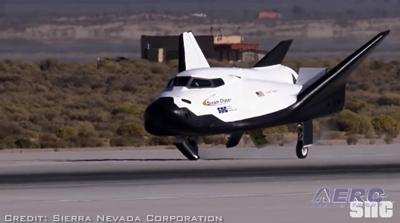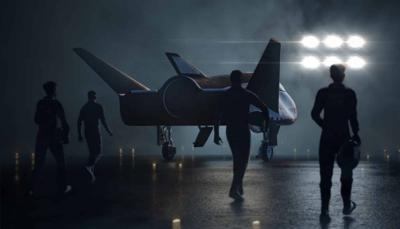Pair to Assist with Dream Chaser Space-Plane Mission to ISS
Sierra Nevada Corporation, colloquially, Sierra Space, is a privately held, American aerospace and national security contractor specializing in aircraft modification and integration, space components and systems, and related technology products for cybersecurity and health. The company is headquartered in Sparks, Nevada, and contracts with the United States Armed Forces, NASA, and private spaceflight companies.

On 25 May 2023, Sierra Space announced it had hosted a training event, during which astronauts representing NASA and Japan’s JAXA space agency learned the inner-workings of the company’s Dream Chaser commercial space-plane.
Currently under development, Dream Chaser is a reusable lifting-body space-plane which, when complete, will be capable of carrying up to seven passengers and cargo to and from Low Earth Orbit (LEO).
Planned in manned and unmanned cargo and passenger variants, Dream Chaser is intended to launch vertically atop United Launch Alliances (ULA) Vulcan Centaur rocket and land horizontally on conventional runways.
Dream Chaser’s design derives of NASA's HL-20 Personnel Launch System space-plane concept, which in turn descended from test vehicles the likes of the X-20 Dyna-Soar; Northrop’s M2-F2, M2-F3, and HL-10; and Martin’s X-24A, X-24B, and X-23 PRIME.
Dream Chaser’s on-orbit propulsion system comprises a cluster of Orbitec's propane-and-nitrous-oxide-burning Vortex engines.
The trainee astronauts—NASA’s Jasmin Moghbeli and JAXA’s Satoshi Furukawa—are members of the upcoming SpaceX Crew-7 mission to the International Space Station (ISS). Dream Chaser is slated to make its maiden voyage—a cargo-carrying mission—to the ISS during Moghbeli’s and Satoshi’s planned six-month stay aboard the orbital facility.
Sierra Space CEO Tom Vice stated: “We are honored to provide NASA cargo resupply missions to the International Space Station. The astronaut training is another important milestone as we complete the final preparations for Dream Chaser’s first mission. Our team provided a comprehensive training experience for these Crew-7 members to prepare them for when Dream Chaser berths at the ISS.”
The eight-hour training session in which Moghbeli and Furukawa partook was conducted on 07 March 2023 at Sierra Space’s Louisville, Colorado, facility. The training, which was divided into four discrete parts, was overseen by Sierra Space company specialists. Parts one and two were didactic undertakings consisting of lectures and classroom presentations. Parts three and four, conversely, were carried out in a full-size mock-up of the Dream Chaser spacecraft.
All told, Moghbelis and Furukawa’s training entailed:
- Part One: Dream Chaser Overview—Moghbeli and Furukawa were briefed on the nature and function of Dream Chaser’s systems, mission profile, and crew interfaces and operations.
- Part Two: Rendezvous and Proximity Operations (RPO)— Moghbeli and Furukawa were familiarized with the timeline, profile, and procedural operations by which Dream Chaser will rendezvous and dock with the ISS.
- Part Three: Dream Chaser Hardware Familiarization and Scenarios—after relocating to the Dream Chaser mock-up, the two astronauts were taught to operate and interface with the spacecraft’s components and systems, to include vehicle ingress and egress procedures and off-nominal scenarios.

Speaking to the subject of the training’s third phase, Sierra Space Flight Operations Mission Training team-member Krista Abler remarked: “This was the portion of the training where the astronauts were blown away by Dream Chaser’s massive size, often commenting, ‘Wow, you can fit a lot of cargo in here.’ You can look at CAD drawings or read about Dream Chaser’s dimensions all day long, but its immense capacity doesn’t really register until you crawl inside. I think this is a reason why NASA is excited about our vehicle.”
- Part Four: Cargo Transfer Scenarios—Moghbeli and Furukawa were taught procedures by which they will install/remove cargo from the Dream Chaser spacecraft on orbit. The pair were familiarized with numerous restraint systems (straps, beams, etc.), identified hazards associated with cargo operations, and ran scenario drills.
Ms. Abler added: “This was probably the most important lesson of the day because the whole point of Dream Chaser coming to the ISS is to deliver cargo.”
 ANN's Daily Aero-Term (12.08.25): Decision Altitude (DA)
ANN's Daily Aero-Term (12.08.25): Decision Altitude (DA) ANN's Daily Aero-Linx (12.08.25)
ANN's Daily Aero-Linx (12.08.25) NTSB Final Report: Piper PA-31T3
NTSB Final Report: Piper PA-31T3 Aero-News: Quote of the Day (12.08.25)
Aero-News: Quote of the Day (12.08.25) Airborne-Flight Training 12.04.25: Ldg Fee Danger, Av Mental Health, PC-7 MKX
Airborne-Flight Training 12.04.25: Ldg Fee Danger, Av Mental Health, PC-7 MKX




